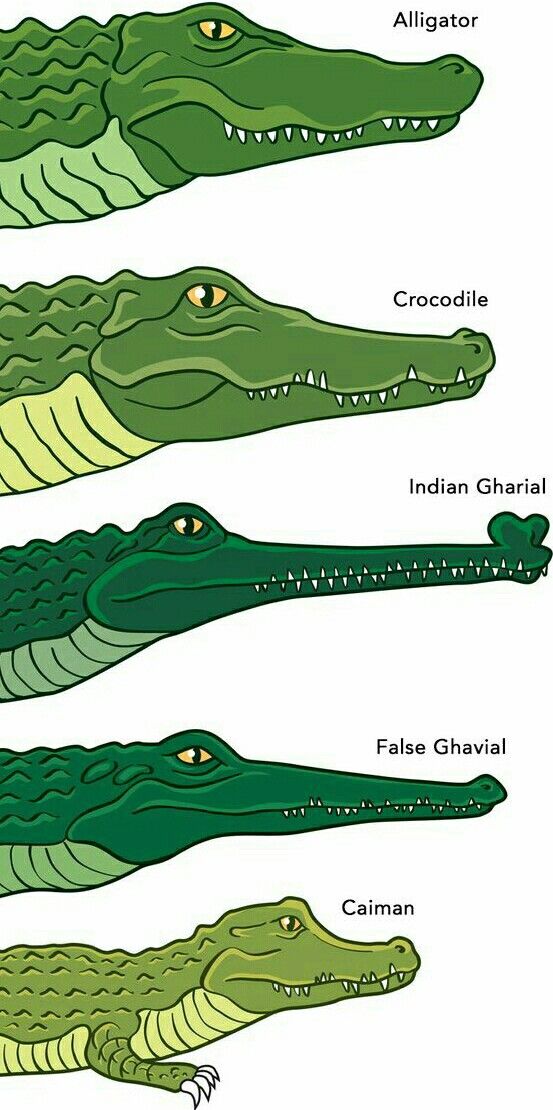Exploring the Enigma: Unraveling the Differences Between Alligators and Crocodiles

In the vast and mysterious realm of reptiles, alligators and crocodiles stand out as apex predators, capturing the imagination of both scientists and enthusiasts. Despite their similar appearances and shared ancestry, these creatures belong to distinct families, each harboring unique characteristics that set them apart. This article delves into the intriguing world of alligators and crocodiles, unraveling the subtle yet significant differences that define these ancient creatures.
Taxonomy and Classification:
To understand the differences between alligators and crocodiles, it’s essential to first explore their taxonomic classifications. Both belong to the order Crocodylia, which encompasses three families: Alligatoridae, Crocodylidae, and Gavialidae. Alligators fall under the family Alligatoridae, while crocodiles belong to the family Crocodylidae. The Gavialidae family consists of gharials, which are distinct from both alligators and crocodiles.
Physical Characteristics:
While alligators and crocodiles share some common physical traits, there are subtle differences that keen observers can use to distinguish between the two. One noticeable distinction is the shape of their snouts. Alligators typically have a U-shaped snout, which is shorter and broader, while crocodiles feature a V-shaped snout that is longer and more pointed. This divergence in snout structure is primarily attributed to their feeding habits and prey preferences.
Teeth and Jaw Structure:
The dental arrangement of alligators and crocodiles also contributes to their differentiation. Alligators possess wider upper jaws that accommodate their teeth when the mouth is closed, creating a neat and concealed appearance. In contrast, crocodiles have a more menacing display of teeth as their upper and lower jaws interlock when the mouth is closed, leaving some of their formidable teeth exposed. This difference in jaw structure is an adaptation to their distinct hunting strategies.
Habitat and Geographic Distribution:
Alligators and crocodiles exhibit variations in their preferred habitats and geographical ranges. Alligators are predominantly found in freshwater habitats such as swamps, lakes, and rivers, with a preference for slower-moving waters. Their distribution is primarily limited to the Americas, with American alligators inhabiting the southeastern United States and the Chinese alligator residing in a small region of eastern China. On the other hand, crocodiles display a broader distribution, inhabiting both freshwater and saltwater environments across Africa, Asia, Australia, and the Americas.
Behavior and Temperament:
The behavior and temperament of alligators and crocodiles differ, reflecting their evolutionary adaptations and ecological roles. Alligators are generally considered less aggressive than crocodiles, exhibiting a more tolerant demeanor towards other members of their species. They are known to construct burrows for shelter and can survive in colder climates, allowing them to endure harsher conditions than their crocodile counterparts. Crocodiles, on the other hand, are often perceived as more aggressive and territorial, displaying higher levels of aggression towards both predators and potential threats.
Salt Glands and Saltwater Tolerance:
One of the distinctive features that sets crocodiles apart from alligators is their ability to tolerate saltwater. Crocodiles possess specialized salt glands located on their tongues, which allow them to excrete excess salt from their bodies. This adaptation enables certain species of crocodiles, such as the saltwater crocodile (Crocodylus porosus), to inhabit estuarine and marine environments. Alligators lack these salt glands, making them predominantly freshwater inhabitants.
Reproductive Differences:
Reproductive strategies vary between alligators and crocodiles, reflecting their ecological adaptations. Alligators construct nests made of vegetation, mud, and debris, usually in close proximity to water. Female alligators guard their nests and eggs, ensuring the safety of their offspring until hatching. In contrast, crocodiles exhibit a range of reproductive behaviors. Some species build mound nests similar to alligators, while others dig holes in the sand or soil. Crocodile mothers are generally less attentive to their nests, and in some cases, they may carry their hatchlings in their mouths to water shortly after hatching.
Conservation Status:
Both alligators and crocodiles face various threats, including habitat loss, pollution, and human-wildlife conflict. However, their conservation status differs among species. Some alligator species, such as the American alligator, have rebounded from past declines and are now listed as least concern by the International Union for Conservation of Nature (IUCN). On the other hand, several crocodile species, including the critically endangered Philippine crocodile and the vulnerable Siamese crocodile, confront more severe conservation challenges.
Cultural Significance:
Alligators and crocodiles hold cultural significance in various societies, often featuring prominently in myths, legends, and folklore. In many indigenous cultures, these creatures are revered as symbols of strength, resilience, and adaptability. Conversely, they can also be viewed as symbols of danger and malevolence. The cultural narratives surrounding alligators and crocodiles highlight the complex relationship between humans and these formidable reptiles.
Conclusion:
In the vast tapestry of the animal kingdom, alligators and crocodiles emerge as enigmatic and captivating creatures. Despite their shared ancestry and similar physical appearances, the subtle differences in their anatomy, behavior, and ecological adaptations set them apart. Understanding these distinctions not only enhances our appreciation for the diversity of life on Earth but also contributes to conservation efforts aimed at preserving these ancient and remarkable reptiles for future generations.
-
Q: What is the main physical difference between alligators and crocodiles?
A: The most noticeable physical difference lies in the shape of their snouts. Alligators have a U-shaped snout, shorter and broader, while crocodiles have a V-shaped snout, longer and more pointed.
-
Q: Are there differences in the dental structure of alligators and crocodiles?
A: Yes, there are differences. Alligators have a dental arrangement that keeps their teeth hidden when the mouth is closed. Crocodiles, however, have a more menacing display of teeth as their upper and lower jaws interlock when closed, leaving some teeth exposed.
-
Q: Do alligators and crocodiles inhabit the same types of environments?
A: While both can be found in aquatic environments, alligators prefer freshwater habitats such as swamps and rivers. Crocodiles, on the other hand, can thrive in freshwater and saltwater environments, adapting to a broader range of habitats.
-
Q: Can you find alligators and crocodiles in the same geographical regions?
A: Alligators are primarily found in the Americas, with species like the American alligator in the southeastern United States. Crocodiles have a more widespread distribution, inhabiting Africa, Asia, Australia, and the Americas.
-
Q: How do the temperaments of alligators and crocodiles differ?
A: Alligators are generally considered less aggressive and more tolerant towards other members of their species. Crocodiles, in contrast, are often perceived as more aggressive and territorial, displaying higher levels of aggression.
-
Q: Do alligators and crocodiles have the same reproductive strategies?
A: While both construct nests for their eggs, there are differences. Alligators typically build nests near water and are known for maternal care, guarding the nest until the eggs hatch. Crocodile reproductive behaviors vary, with some species displaying less attentiveness to their nests.
-
Q: Can alligators survive in colder climates compared to crocodiles?
A: Yes, alligators are generally more tolerant of colder climates than crocodiles. Their ability to endure harsher conditions is attributed to their capacity to construct burrows for shelter.
-
Q: Do alligators and crocodiles face similar conservation challenges?
A: While both face threats such as habitat loss and human-wildlife conflict, their conservation statuses vary. Some alligator species, like the American alligator, are listed as least concern, whereas certain crocodile species, such as the Philippine crocodile, are critically endangered.
-
Q: Are alligators and crocodiles significant in cultural narratives?
A: Yes, they hold cultural significance in various societies. Both creatures are often symbols of strength, resilience, and danger, featuring prominently in myths, legends, and folklore across different cultures.
-
Q: Can crocodiles tolerate saltwater, and do alligators possess the same ability?
A: Crocodiles have specialized salt glands on their tongues, allowing them to tolerate saltwater. Alligators lack these glands, making them predominantly freshwater inhabitants.




